Today, you are going to embark on a journey that will unlock the secrets to creating a truly captivating home—one that reflects your personality, evokes emotion, and captures the essence of who you are. And what’s the secret ingredient that brings it all together? It’s the art of accessorizing. This is a game changer!
You see, accessorizing is like the icing on the cake, the cherry on top—it’s the final touch that takes your space from ordinary to extraordinary. It’s where your personal style truly comes to life, where you can infuse your space with soul and character. And when it comes to accessorizing, there’s no better technique than the art of layering.
Imagine your home as a beautifully crafted painting, with each layer adding depth, dimension, and visual interest. Layering is the secret sauce that turns a plain canvas into a masterpiece. It’s the delicate balance between different elements, textures, and colors that creates a harmonious and inviting atmosphere. It’s where magic happens.

Images via Pinterest.
Throughout this blog post, we’re going to explore the intricacies of layering and how it can completely transform your space. We’ll start by understanding the fundamentals of layering and the purpose it serves in home decor. We’ll then journey through the various layers—textiles, wall decor, accessories, and lighting—unveiling the techniques and strategies that will help you achieve a truly curated and inviting home.
Whether you’re a seasoned design enthusiast or just starting your home decor journey, this blog post will inspire and guide you towards creating a space that not only looks incredible but also feels like a true reflection of your unique self. Get ready to unlock your creativity, embrace the power of layering, and let your home tell your story.
So, let’s dive in and discover the art of accessorizing your home through the transformative magic of layering. Get ready to bring out the inner designer within you and create a home that’s as exceptional as you are.
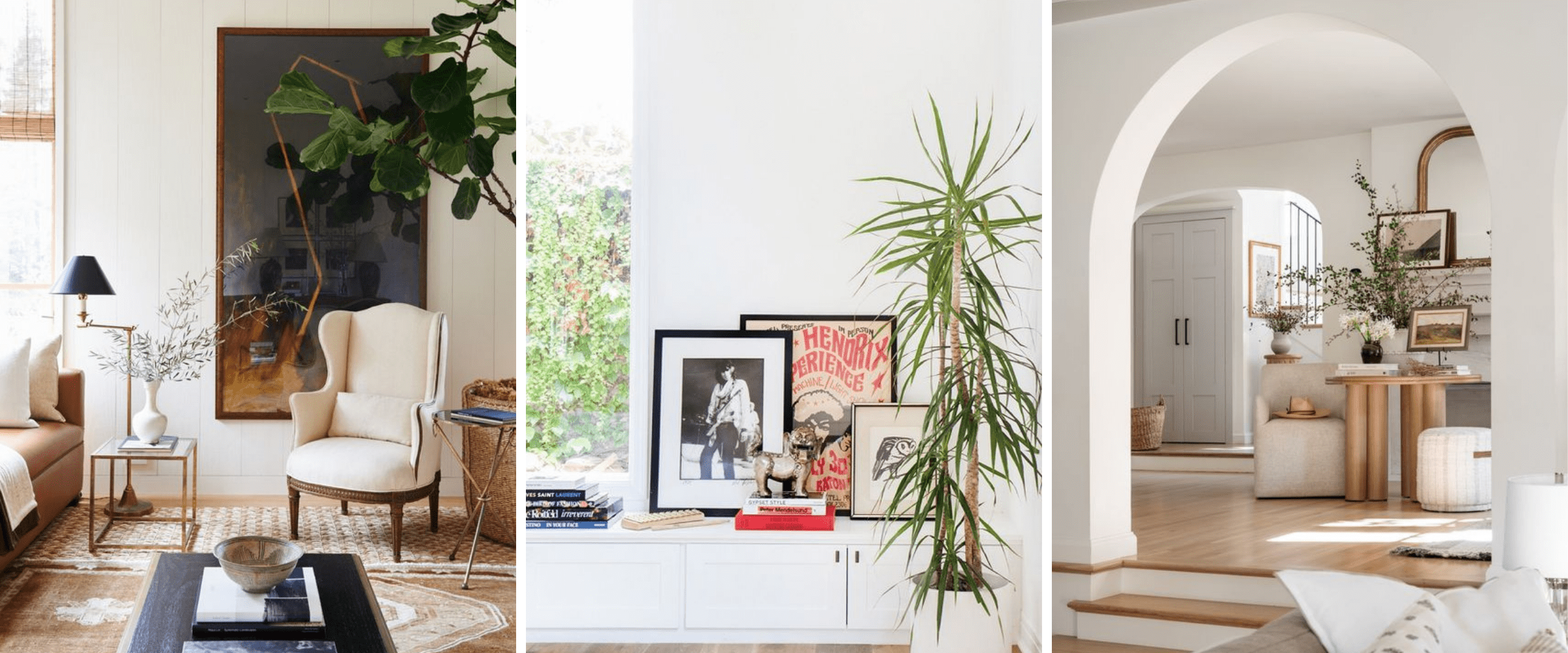
Images via Pinterest.
Understanding Layering
Think of layering as the secret recipe that adds depth, personality, and a touch of enchantment to your interiors. It’s a skill that takes your space from mere functionality to a visually stunning and inviting haven. So, let’s delve deeper into the art of layering and unravel its transformative potential.
Layering, in the context of home decor, involves thoughtfully combining different elements to create a cohesive and visually engaging space. It’s about orchestrating a symphony of colors, textures, and styles that work harmoniously together. When executed with finesse, layering can elevate your home to new heights, making it truly memorable and reflective of your personal style.
The purpose of layering is twofold. First, it adds depth and dimension to your space. By incorporating layers, you create visual interest and make the eye wander, discovering new elements at every glance. It prevents your home from feeling flat or one-dimensional, instead infusing it with a sense of richness and complexity.
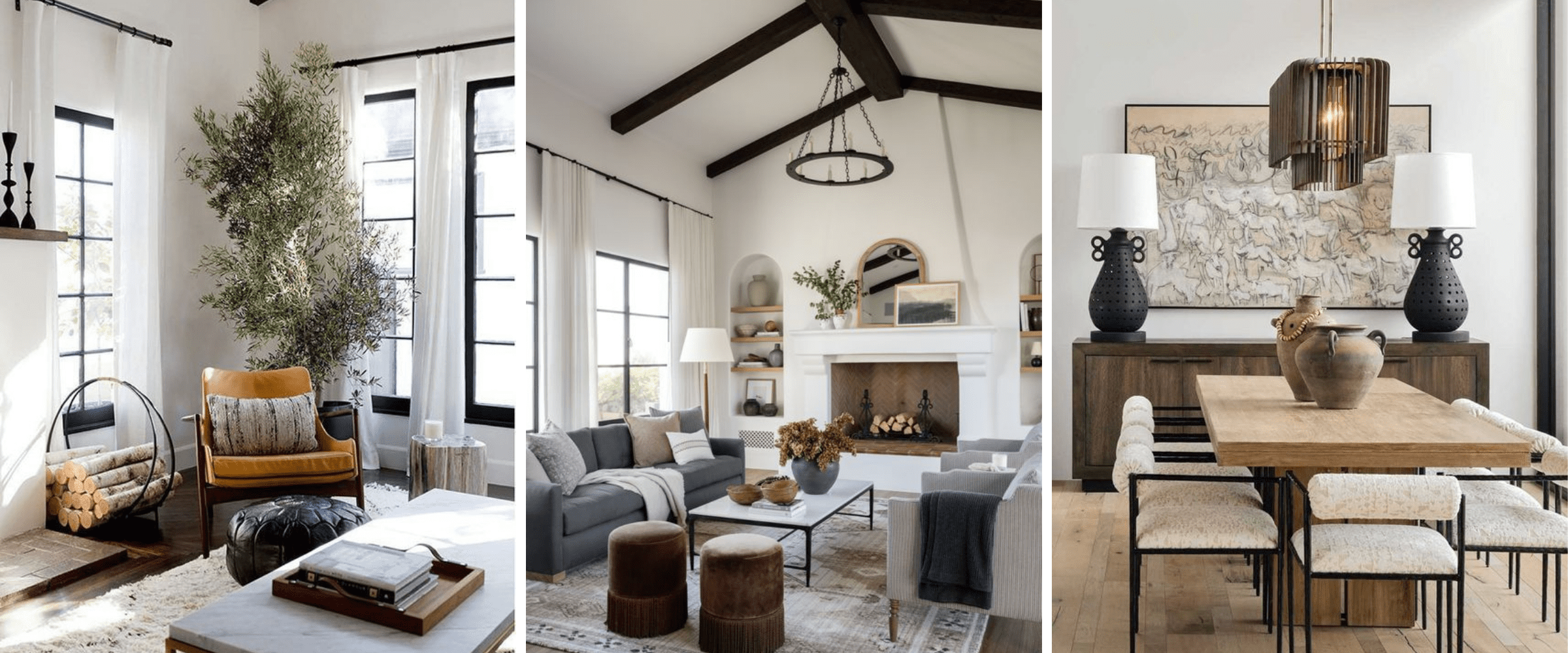
Images via Pinterest.
Second, layering allows you to infuse your personality and style into your space. Each layer represents an opportunity for self-expression. It’s a chance to showcase your taste, preferences, and unique story. Whether you opt for bold and vibrant layers or prefer a more subdued and tranquil approach, layering empowers you to curate a space that speaks to who you are.
To achieve successful layering, it’s essential to pay attention to the different layers that make up your home decor. Let’s take a closer look at each layer and explore how they contribute to the overall aesthetic.
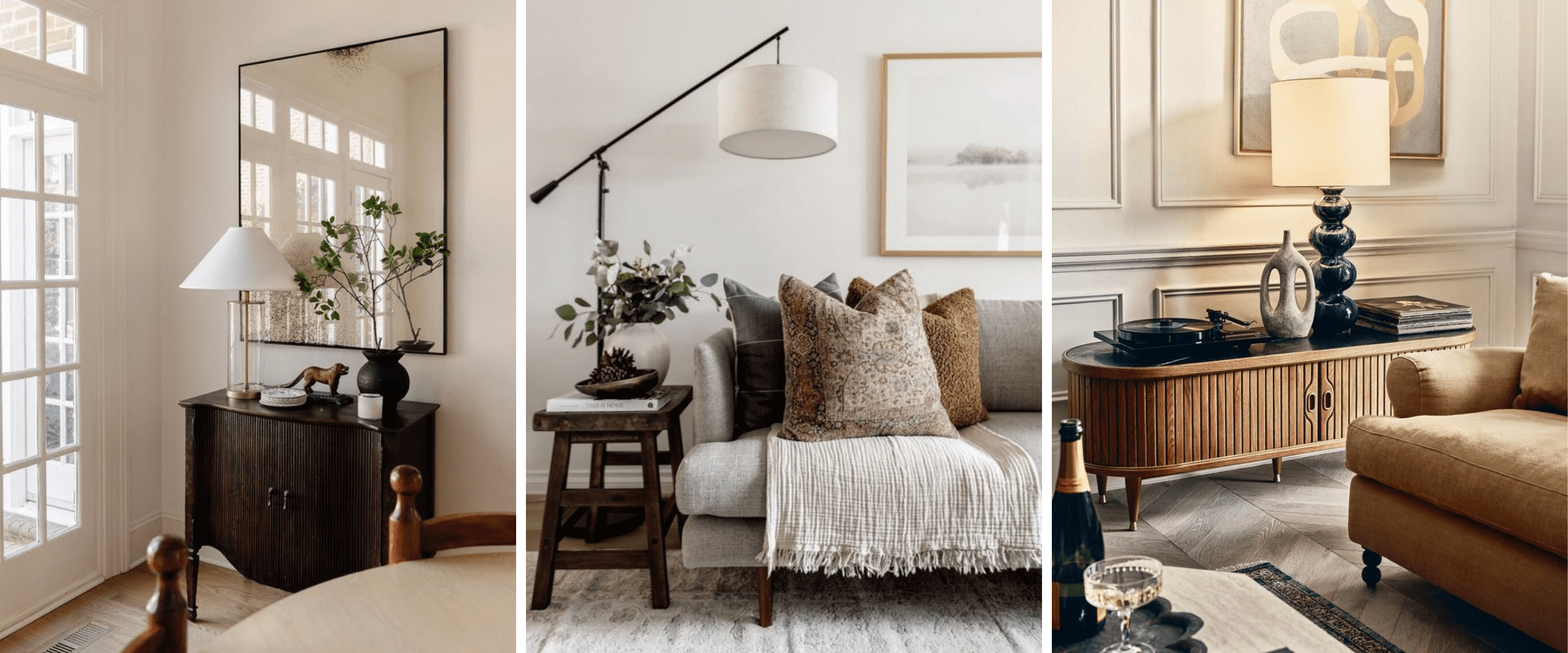
Images via Pinterest.
Creating a Solid Foundation
When it comes to accessorizing your home through the art of layering, establishing a solid foundation is essential. Just as a well-built structure relies on a strong foundation, your home’s design depends on a solid base that sets the stage for your accessories to shine. Let’s explore the key aspects of creating a solid foundation for your layered decor.
Thoughtful Furniture Selection
Begin by carefully selecting furniture pieces that not only align with your personal style but also harmonize with one another. Consider the scale, proportion, and functionality of each item. Whether you prefer sleek and modern or classic and traditional, choose pieces that complement each other and create a cohesive look throughout the space. The furniture acts as the anchor for your accessories, providing the framework on which to build your layered design.
Colors and Textures
The color palette and textures you choose for your furniture and surfaces play a crucial role in establishing a solid foundation. Opt for colors that evoke the desired mood and ambiance, whether it’s calming neutrals, vibrant pops of color, or sophisticated monochromatic schemes. Additionally, explore different textures to add depth and tactile interest. Combine smooth and sleek surfaces with textured fabrics or natural materials to create a visually engaging environment.
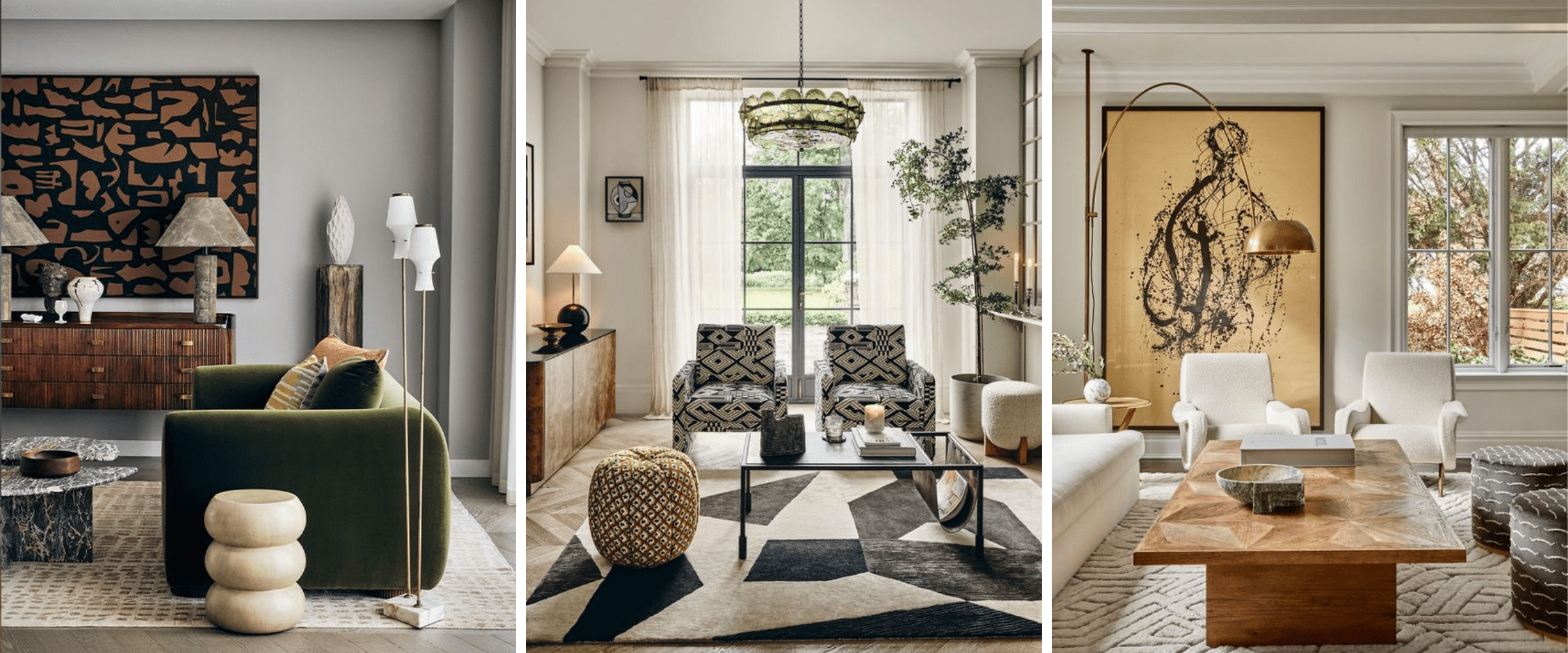
Images via Pinterest.
Rugs and Floor Coverings
Rugs and floor coverings are not only functional but also contribute to the foundation of your layered design. They serve as anchors for different zones within a room, tying everything together.
Choose rugs that complement the furniture and overall color scheme while also providing a sense of warmth and coziness. Explore various patterns, textures, and sizes to find the perfect rug that sets the stage for your layered decor.
Window Treatments
Window treatments are often overlooked but can significantly impact the overall aesthetic of a space. They not only control natural light and provide privacy but also contribute to the layering process. Consider curtains, blinds, or shades that complement the style and colors of your furniture and walls. Pay attention to the fabric choices, as they can add texture and visual interest. Window treatments create a polished and finished look while enhancing the foundation of your layered design.
By carefully selecting furniture, colors, textures, rugs, and window treatments, you establish a solid foundation that sets the tone for your layered decor. This foundation acts as the canvas upon which you’ll layer additional elements, creating a visually stunning and harmonious space.
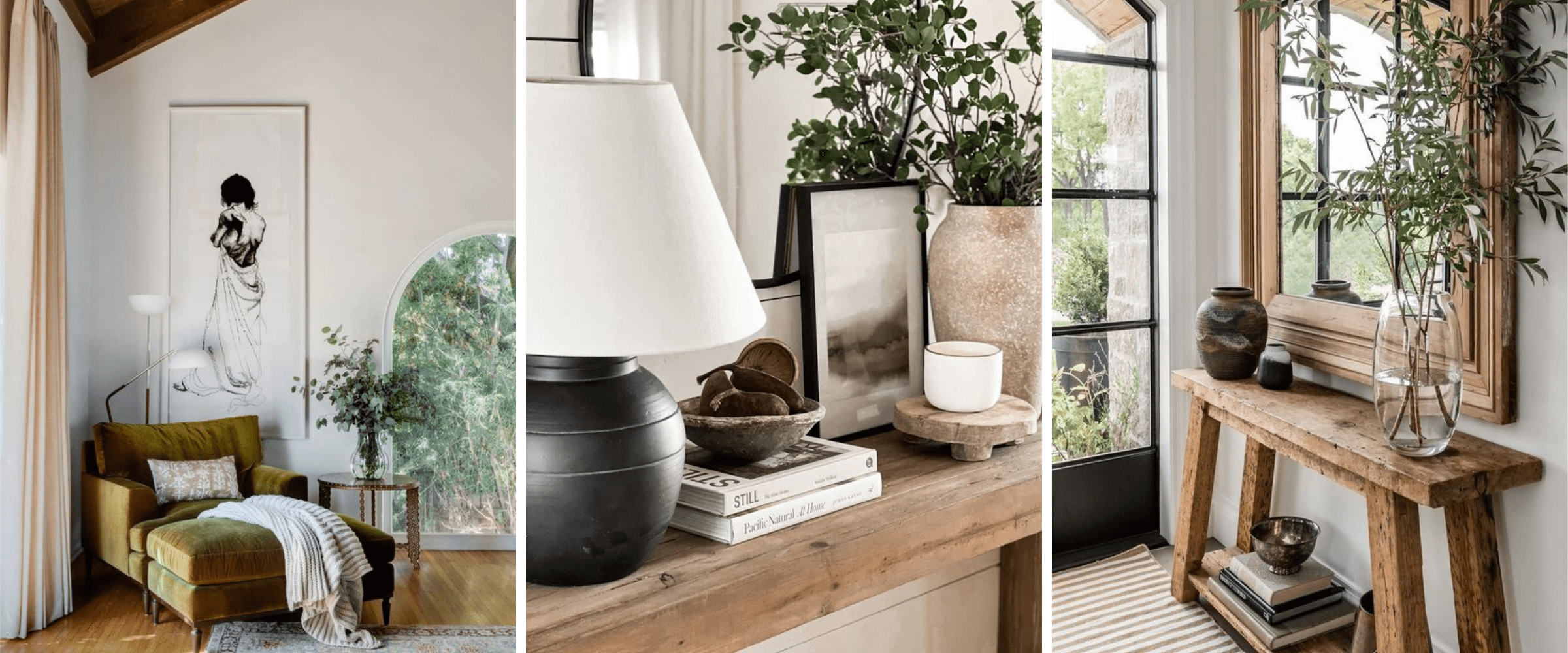
Images via Pinterest.
Layering with Textiles
When it comes to accessorizing your home through the art of layering, textiles play a pivotal role in adding comfort, personality, and visual interest to your space. From throw pillows and cushions to blankets and rugs, textiles offer endless opportunities to create cozy and inviting layers. Let’s explore the art of layering with textiles and discover how they can transform your home.
Throw Pillows and Cushions
Adding throw pillows and cushions is one of the simplest and most impactful ways to introduce layers of texture and color to your space. Mix and match different shapes, sizes, patterns, and fabrics to create a dynamic and visually engaging arrangement. Consider combining solid colors with bold patterns or playing with varying textures like velvet, linen, or faux fur. Layering pillows and cushions on sofas, chairs, or beds instantly adds depth and a cozy touch to any room.
Blankets and Throws
Blankets and throws not only provide warmth and comfort but also offer an additional layer of visual interest. Drape a cozy throw over the arm of a sofa or place a textured blanket at the foot of your bed to invite relaxation and create an inviting atmosphere. Experiment with different materials, such as knitted, woven, or chunky cable-knit blankets, to add texture and dimension. By layering blankets and throws, you infuse your space with a sense of coziness and visual depth.
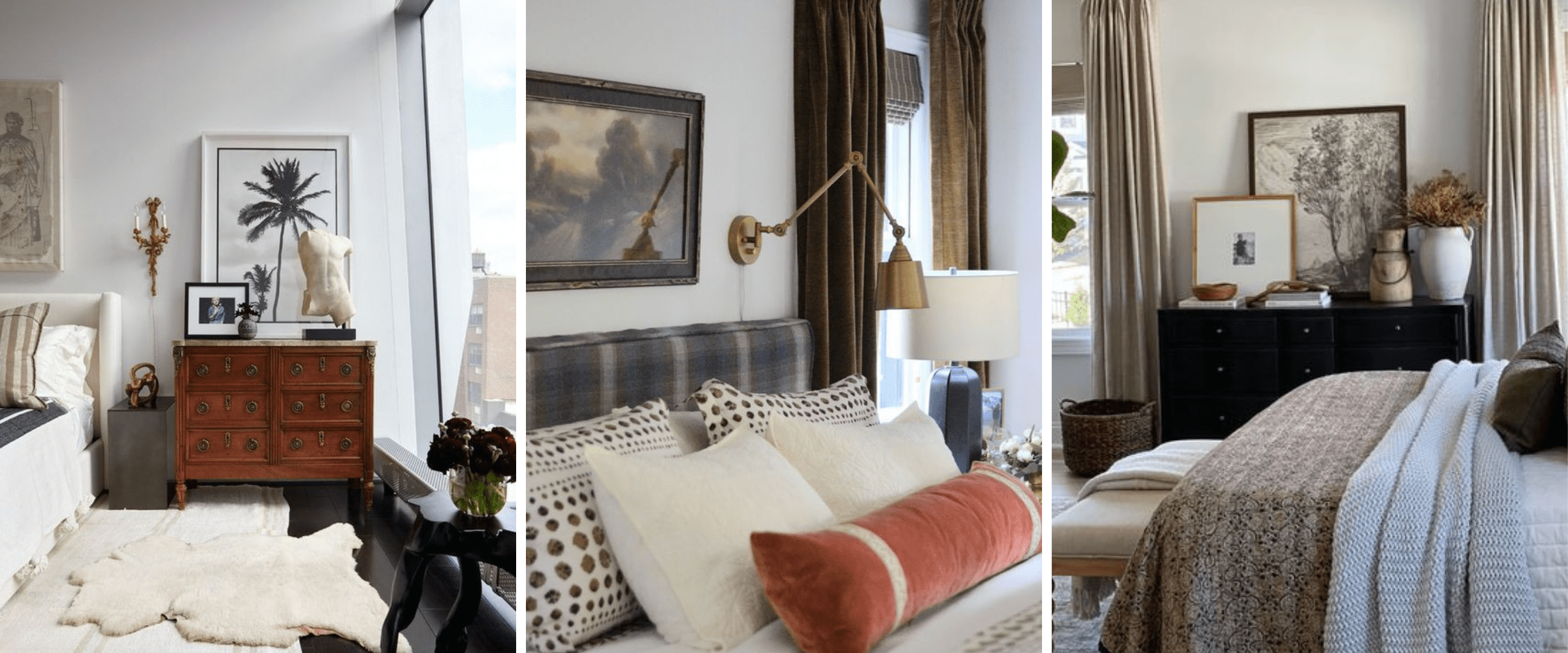
Images via Pinterest.
Area Rugs
Area rugs are a fantastic way to define spaces and add texture to your floors. They anchor furniture groupings and provide a foundation for layering other elements. Choose rugs that complement your furniture and overall design aesthetic. Whether you prefer bold patterns, subtle neutrals, or natural fibers, rugs add depth and warmth to your space. Layer smaller rugs on top of larger ones to create a captivating visual effect and further enhance the layered look.
Curtains and Draperies
While often considered a functional element, curtains and draperies are an excellent opportunity to introduce another layer of textiles into your space. They frame windows, add softness, and contribute to the overall aesthetic. Consider the fabric choice, length, and pattern of your curtains to align with your desired style. Layer sheer curtains underneath heavier drapes for a delicate and ethereal effect, or opt for a single panel for a more minimalist approach.
Upholstery and Slipcovers
Don’t forget the impact of upholstered furniture and slipcovers in your layering strategy. The choice of fabric for your sofas, chairs, and ottomans can greatly influence the overall texture and visual appeal of a room. Experiment with different fabric choices, such as velvet, linen, or leather, to achieve the desired look. Slipcovers also offer versatility, allowing you to change the color or pattern of your furniture seasonally or as your style preferences evolve.
When layering with textiles, remember that balance and coordination are key. Consider the color palette, patterns, and textures of your existing furniture and decor, and select textiles that harmonize and enhance the overall aesthetic. Mix and match different textiles, but be mindful of maintaining a cohesive look throughout your space.
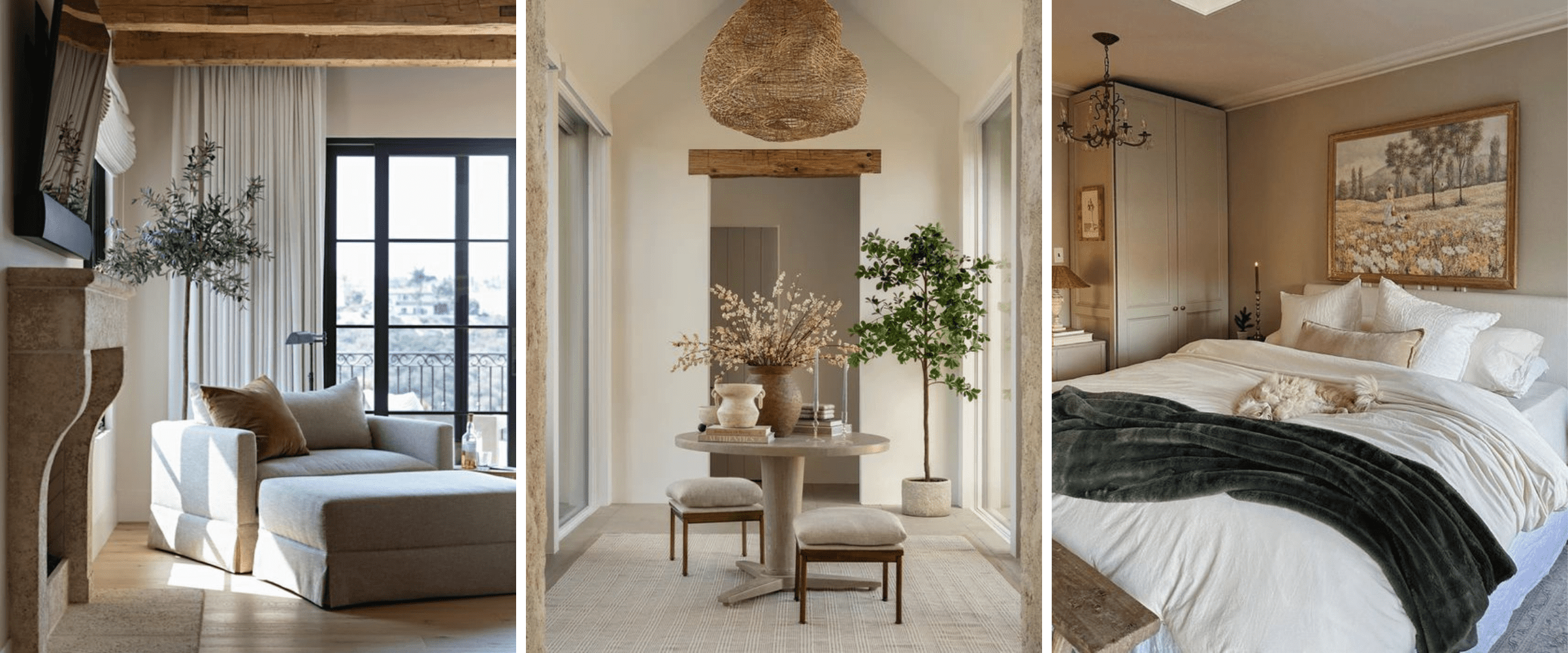
Images via Pinterest.
Layering Lighting
Lighting is a crucial element in creating the desired ambiance and enhancing the overall atmosphere of your home. When it comes to accessorizing your space through the art of layering, incorporating multiple sources of lighting adds depth, dimension, and functionality. By combining different types of lighting, you can create a layered effect that not only illuminates your space but also sets the mood and highlights key areas. Let’s explore the art of layering lighting and discover how it can transform your home.
Ambient Lighting
Ambient lighting serves as the foundational layer of illumination in a room. It provides overall illumination and sets the general mood and brightness level. This can be achieved through ceiling-mounted fixtures, chandeliers, or recessed lighting. Consider the size and layout of your space when choosing the type and placement of ambient lighting. Opt for dimmable options to adjust the level of brightness according to different activities and occasions.
Task Lighting
Task lighting is focused lighting that serves a specific purpose, such as reading, cooking, or working. It provides targeted illumination to enhance functionality and prevent eye strain. Desk lamps, under-cabinet lights in the kitchen, and adjustable floor lamps are examples of task lighting. Place task lights strategically in areas where you need focused illumination, such as desks, kitchen countertops, or reading nooks. This layer of lighting ensures that specific tasks are well-lit and easily manageable.
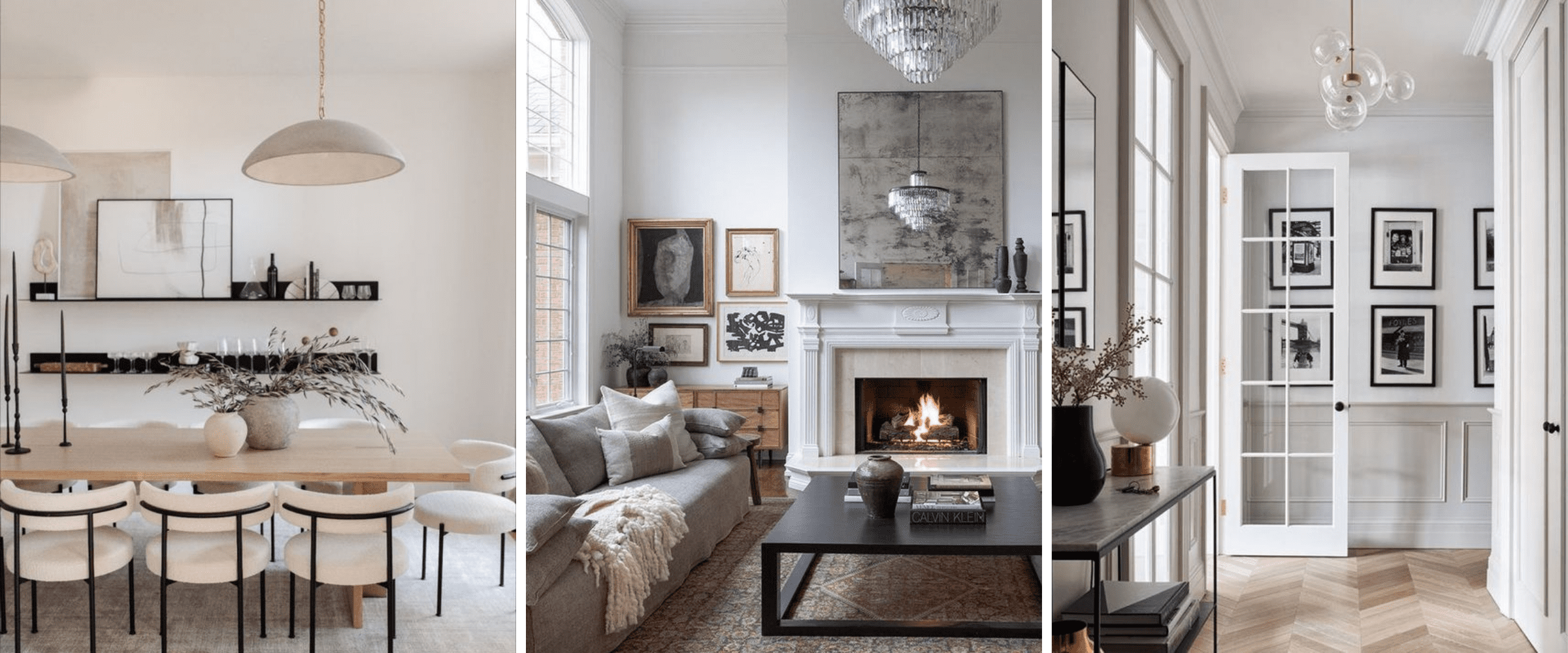
Images via Pinterest.
Accent Lighting
Accent lighting adds drama, depth, and visual interest to your space by highlighting specific architectural features, artwork, or decorative elements. This layer of lighting creates focal points and draws attention to the objects you want to showcase. Use adjustable spotlights, track lighting, or picture lights to highlight artwork, sculptures, or architectural details like textured walls or stone finishes. The placement and angle of accent lighting are critical to creating the desired effect.
Decorative Lighting
Decorative lighting serves as both a functional and aesthetic element in your layered lighting design. These are statement pieces that add a touch of style and personality to your space. Chandeliers, pendant lights, and decorative sconces are examples of decorative lighting. Choose fixtures that complement your overall design aesthetic and act as focal points in your room. These fixtures can enhance the visual appeal of your space even when they are turned off.
Natural Lighting
Don’t forget the importance of natural lighting in your layering strategy. Maximizing natural light through windows, skylights, and glass doors not only provides a sense of openness but also helps create a seamless connection with the outdoors. Use sheer or light-filtering window treatments to allow natural light to flow in while maintaining privacy. Natural light serves as a beautiful base layer that can be complemented and enhanced with artificial lighting.
When layering lighting, it’s important to consider the different purposes and activities that take place in each area of your home. Pay attention to the color temperature of the bulbs you choose, opting for warm or cool lighting depending on the desired mood. Incorporate dimmers and smart lighting systems to have control over the intensity and color of your lights.
By layering different types of lighting, you can create a dynamic and versatile environment that adapts to your needs and enhances the overall aesthetic of your space. So, embrace the art of layering lighting and let it illuminate and transform your home into a welcoming and visually captivating haven.
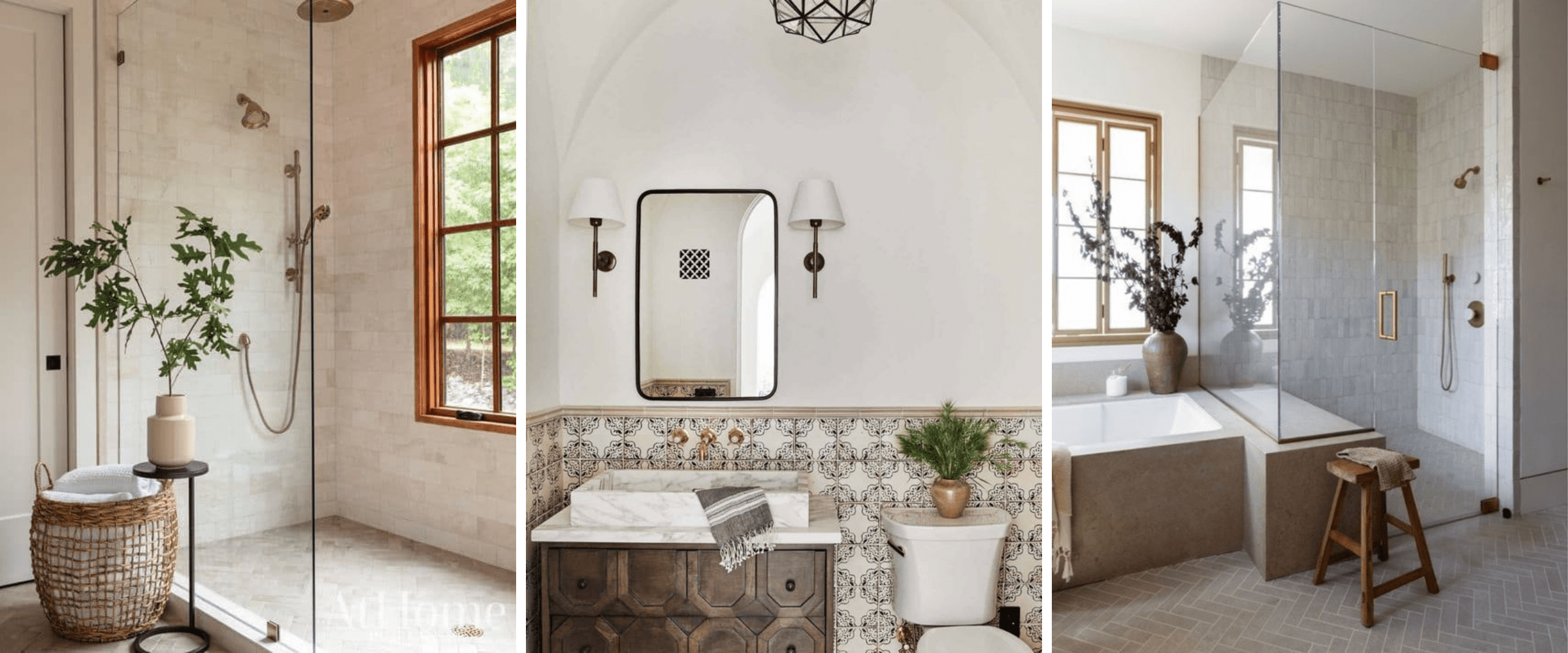
Images via Pinterest.
Personalizing with Wall Decor
Wall decor is like the jewelry of your home—it adds the perfect finishing touches, elevates the aesthetic, and reflects your unique personality and style. When it comes to accessorizing your home through the art of layering, wall decor plays a significant role in creating focal points, adding visual interest, and infusing your space with a personal touch. Let’s explore the exciting world of wall decor and discover how to personalize your home with style.
Artwork
Artwork is a powerful medium for self-expression and can instantly transform the atmosphere of a room. Whether you’re a fan of paintings, prints, photographs, or mixed media, art pieces offer endless possibilities for personalization. Consider selecting artwork that resonates with you, evokes emotions, or represents your interests and passions. Mix and match different sizes, styles, and frames to create a curated gallery wall or let a single statement piece take center stage.
Photographs and Gallery Displays
Displaying cherished photographs is a wonderful way to infuse your home with memories and personal connections. Create a gallery of family photos, travel snapshots, or significant moments that hold sentimental value. Choose frames that complement your decor and experiment with various arrangements, such as grids, asymmetrical groupings, or stair-step displays. Personalize the gallery with a mix of color and black-and-white prints for added visual interest.
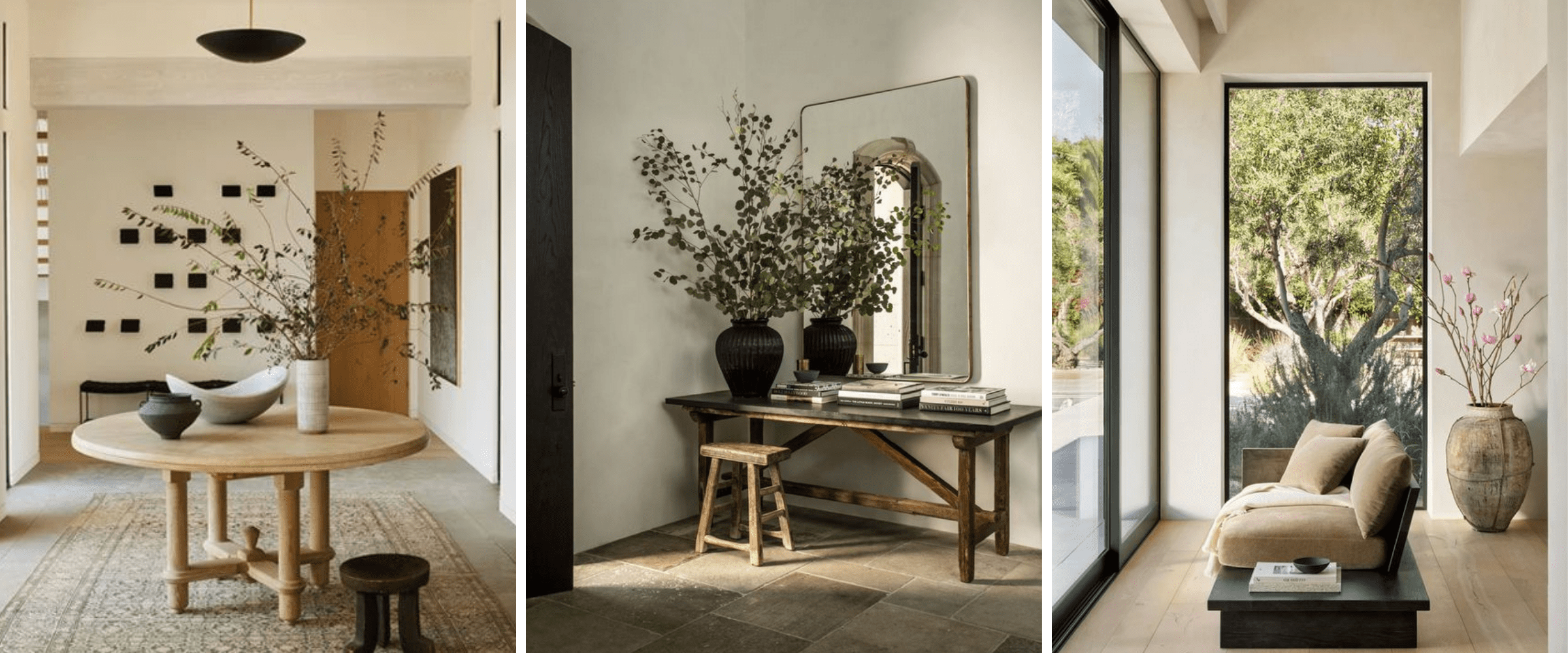
Images via Pinterest.
Mirrors
Mirrors are not only functional but also serve as stunning decorative elements. They reflect light, create an illusion of space, and add a touch of glamour to any room. Choose mirrors with unique frames or interesting shapes to make a statement. Experiment with different sizes and orientations to create visual intrigue. Hang mirrors strategically to capture and reflect natural light, making your space feel brighter and more expansive.
Wall Shelves and Display Units
Wall shelves and display units provide an opportunity to showcase your favorite objects and collectibles. From books and vases to sculptures and plants, arrange them on shelves to add depth and personality to your walls. Incorporate a mix of textures, heights, and colors for a visually dynamic display. Don’t be afraid to update and rotate the items on your shelves to keep the look fresh and evolving.
Wall Decals and Wallpaper
If you’re looking for a more unconventional way to personalize your walls, consider wall decals or wallpaper. Wall decals offer removable and customizable designs, allowing you to create unique patterns or inspirational quotes. Wallpaper, on the other hand, offers an array of patterns, colors, and textures to transform your walls into works of art. Use decals or wallpaper as an accent wall or to add visual interest to smaller spaces like bathrooms or hallways.
When personalizing with wall decor, remember that it’s all about creating a cohesive and meaningful narrative. Mix and match different types of wall decor, but ensure they align with your overall design aesthetic and reflect your personality. Consider the scale of your walls and the surrounding furniture to achieve a balanced and visually pleasing composition.
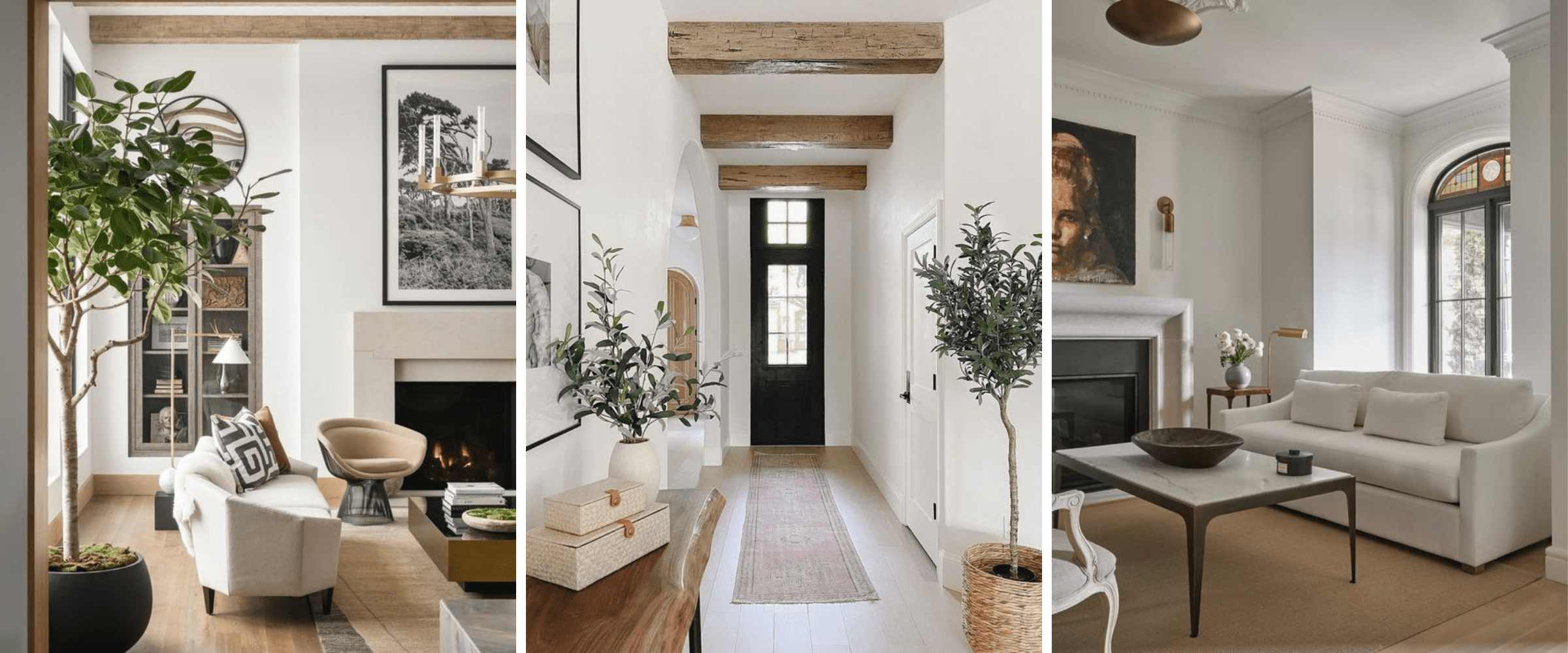
Images via Pinterest.
Styling with Accessories
Accessories are the final layer in the art of home decor layering. They are the small but mighty details that tie everything together and elevate your space to the next level. From vases and candles to sculptures and plants, accessories offer endless opportunities to add personality, texture, and visual interest. Let’s delve into the world of styling with accessories and discover how to create a curated and cohesive look in your home.
Vases and Floral Arrangements
Vases and floral arrangements bring life and freshness to any space. Choose vases in various shapes, sizes, and materials to add visual diversity. Fill them with fresh flowers, branches, or dried botanicals for an instant pop of color and natural beauty. Experiment with different heights and textures to create a captivating display. Consider the seasonality of flowers and change the arrangements accordingly to keep your space feeling vibrant and alive.
Candles and Candle Holders
Candles are not only a source of soft, ambient lighting but also add a warm and cozy atmosphere to your home. Select candles in different shapes, sizes, and scents to create a multi-sensory experience. Pair them with stylish candle holders or lanterns that match your decor style. Cluster candles of varying heights together to create a captivating centerpiece or place them strategically to add a touch of romance and tranquility to your space.
Sculptures and Art Objects
Sculptures and art objects are conversation starters and statement pieces that reflect your personal taste and style. Choose objects that resonate with you or showcase your interests and passions. They can be made of various materials like wood, metal, or ceramic. Arrange them on shelves, side tables, or mantels to add a touch of artistry and visual intrigue. Mix different sizes and shapes to create a curated collection that tells a story.
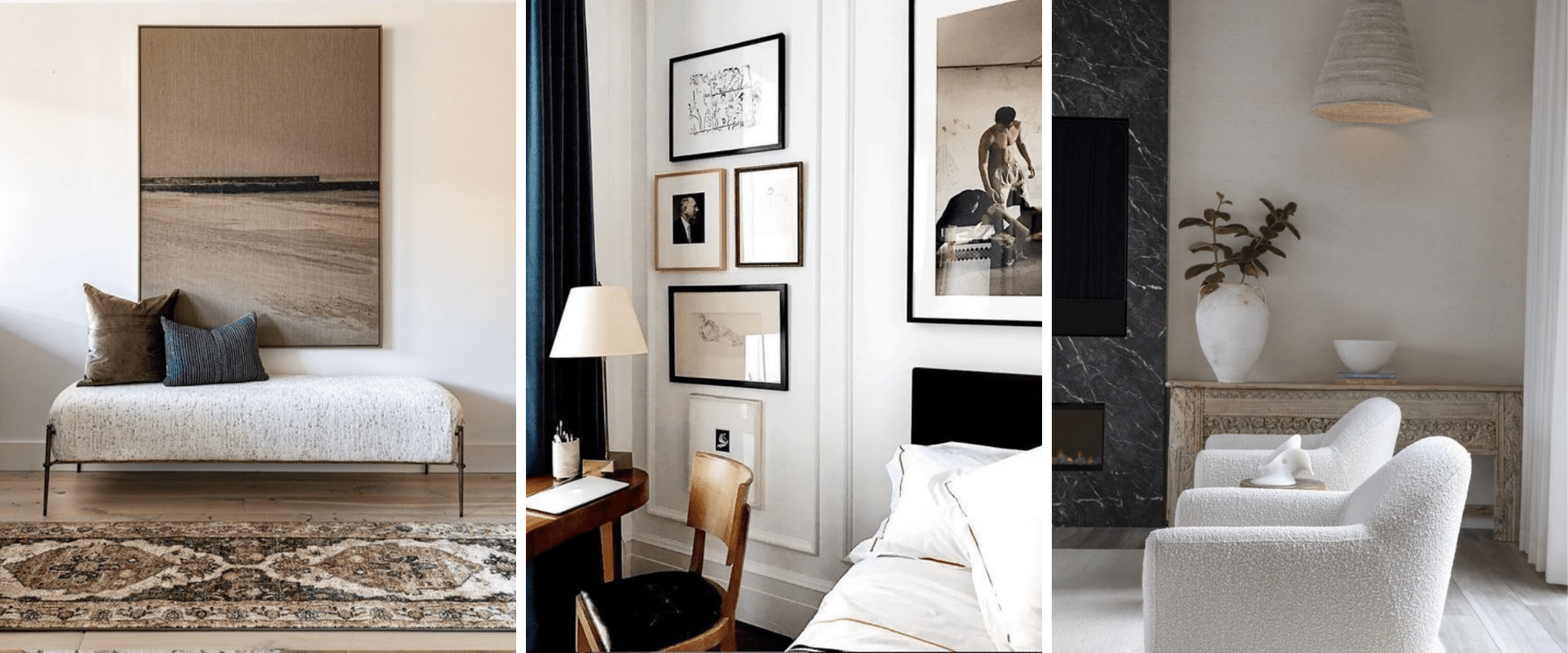
Images via Pinterest.
Books and Coffee Table Displays
Books are not just for reading; they are also great accessories that add character and sophistication to your space. Display books on coffee tables, shelves, or consoles, incorporating them into your decor. Choose books with beautiful covers or ones that align with your interests and hobbies. Stack them horizontally and vertically, interspersed with decorative objects or small sculptures, to create a stylish and personalized vignette.
Plants and Greenery
Plants bring life and a breath of fresh air into your home. They add a sense of serenity, purify the air, and create a connection to nature. Choose plants that thrive in your home‘s lighting conditions and match your ability to care for them. From large floor plants to small succulents or hanging planters, incorporate greenery in various sizes and heights throughout your space. Place them on side tables, shelves, or windowsills to infuse your home with a touch of natural beauty.
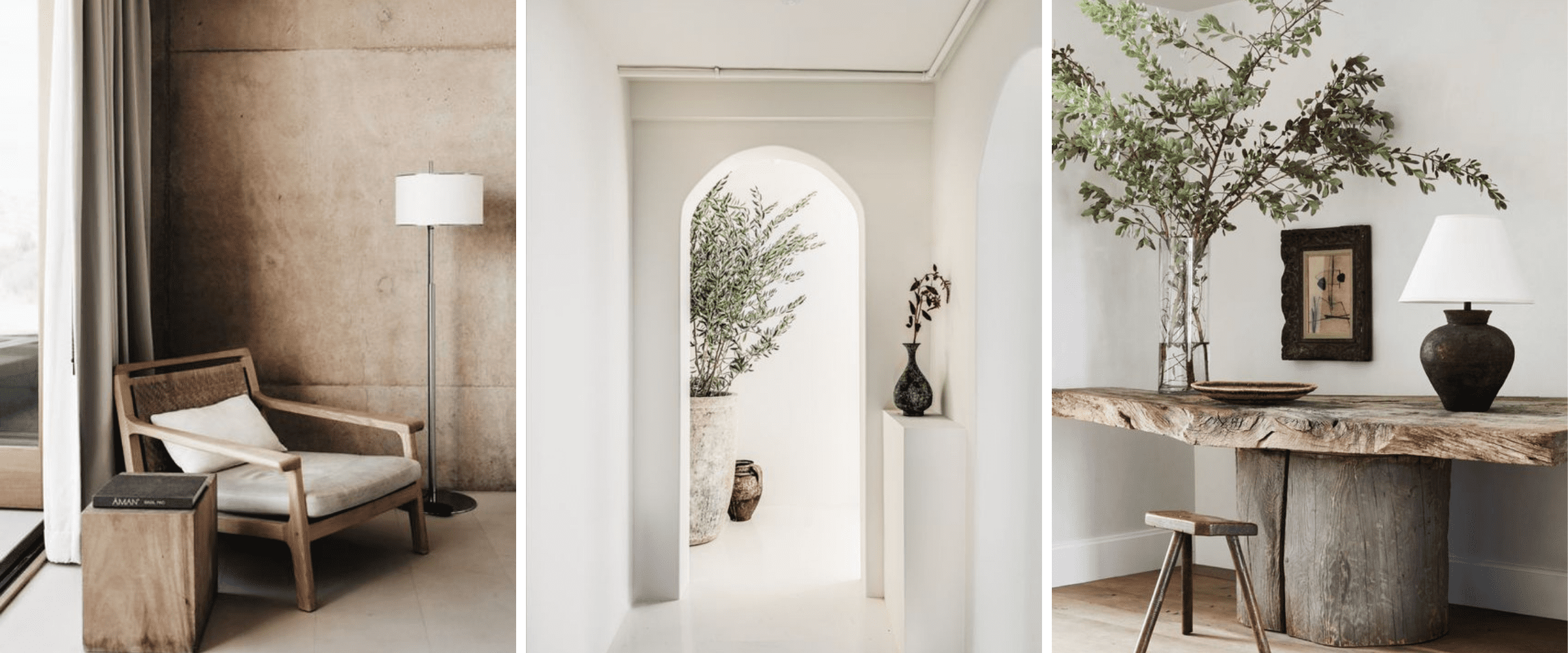
Images via Pinterest.
Maintaining Balance and Harmony
When it comes to accessorizing your home through the art of layering, maintaining balance and harmony is crucial. It’s not just about adding elements, but also about arranging them in a way that creates a cohesive and visually pleasing composition. Achieving balance and harmony ensures that your space feels harmonious, comfortable, and aesthetically appealing.
It’s important to strike a balance between simplicity and visual interest. Avoid overcrowding and clutter by selecting a few key pieces that complement your overall design aesthetic. Group items in odd numbers for a visually pleasing arrangement, and consider the composition, heights, and proportions of the accessories to achieve a harmonious look.
Let’s explore some key principles and tips for maintaining balance and harmony in your layered home decor.
Symmetry and Asymmetry
Both symmetrical and asymmetrical arrangements can create balance and visual interest in a space. Symmetry involves mirroring elements on either side of a central point, creating a sense of order and formality. Asymmetry, on the other hand, involves arranging elements in a way that is visually balanced but not perfectly mirrored. Experiment with both approaches to see which one aligns better with your personal style and the overall aesthetic of your space.
Scale and Proportion
Pay attention to the scale and proportion of the objects and furniture you incorporate into your layered design. Each item should relate harmoniously to the others in terms of size, height, and volume. Avoid overcrowding or overwhelming a space with oversized or undersized elements. Instead, aim for a balanced mix of larger statement pieces and smaller complementary accessories. This creates a sense of harmony and allows each item to shine in its own right.
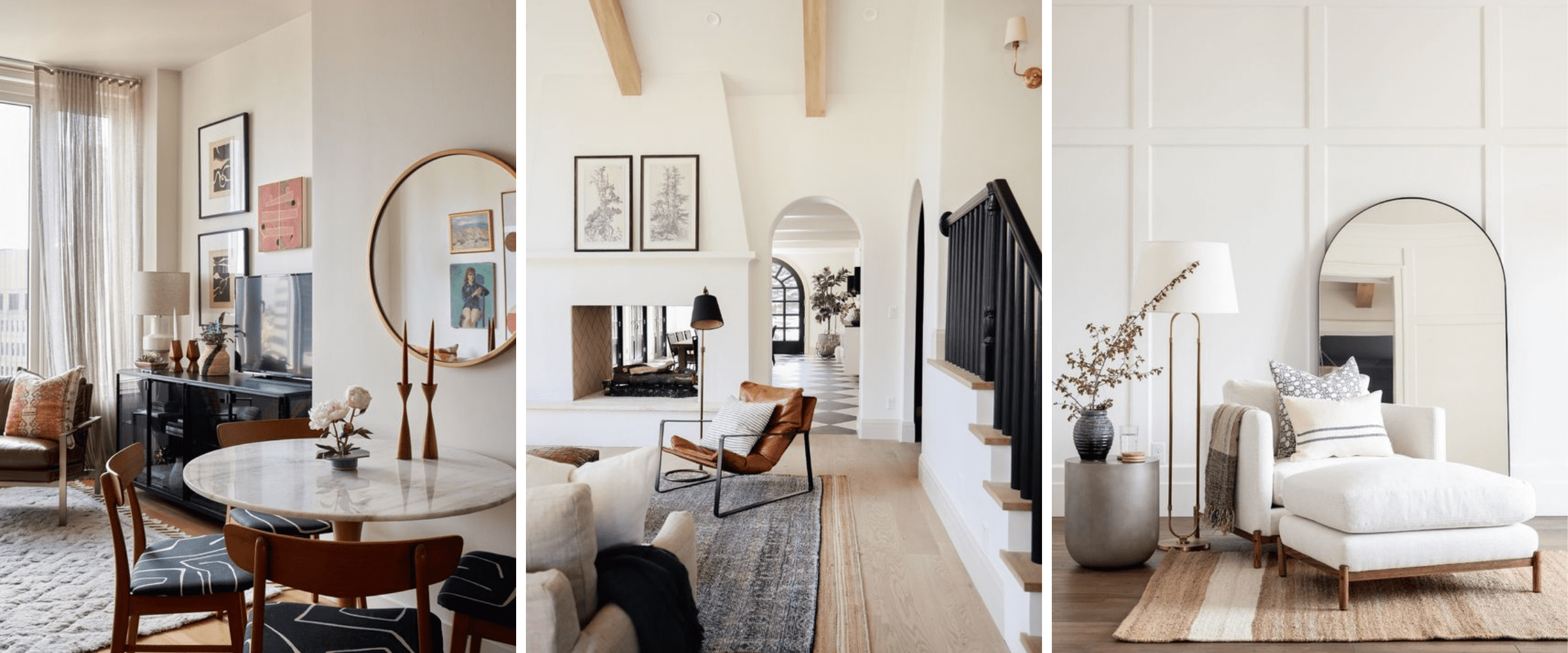
Images via Pinterest.
Color Palette
A cohesive color palette is essential for maintaining balance and harmony in your home decor. Choose a color scheme that complements the overall style and mood you want to achieve. Consider using a combination of neutral tones as a base and then introduce pops of color through accessories or accent pieces. Aim for a balanced distribution of color throughout the space to create a harmonious flow from one area to another.
Texture and Materials
Texture and materials play a significant role in creating depth and tactile interest in your layered design. Consider mixing a variety of textures such as smooth, rough, soft, or shiny. Combine materials like wood, metal, glass, and fabric to add visual and tactile diversity. However, be mindful of balancing the textures and materials to create a cohesive look. Too much variation can create a chaotic or cluttered effect, while too little can make the space feel flat and uninteresting.
Negative Space
Don’t overlook the power of negative space in maintaining balance and harmony. Negative space refers to the empty or unoccupied areas in a room. It allows the eye to rest and creates a sense of visual breathing room. Embrace the concept of less is more and avoid overcrowding your space with too many accessories or furniture pieces. Leave some areas intentionally empty to allow the focal points and key elements to shine.
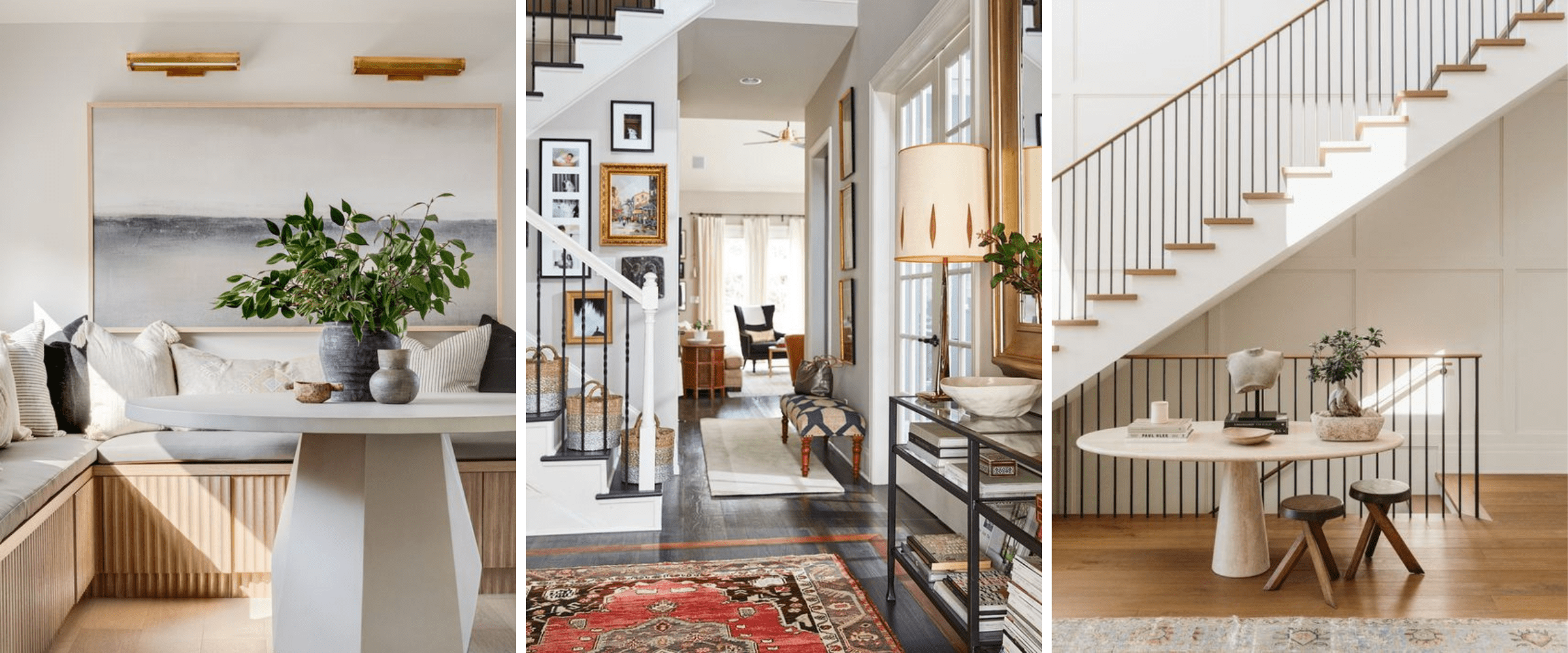
Images via Pinterest.
Flow and Sightlines
Consider the flow and sightlines within your space to ensure a sense of harmony. Arrange furniture and accessories in a way that allows for smooth movement and unobstructed views. Create natural pathways that guide the eye from one area to another, and ensure that key elements are visible and well-positioned. By considering the flow and sightlines, you can create a sense of unity and coherence throughout your space.
Remember that maintaining balance and harmony is an ongoing process. Regularly assess your space, experiment with different arrangements, and make adjustments as needed. Trust your instincts and let your personal style guide you, but also be open to trying new ideas and approaches.
By paying attention to the principles of balance and harmony, you can create a layered home decor that not only looks beautiful but also feels harmonious and inviting.
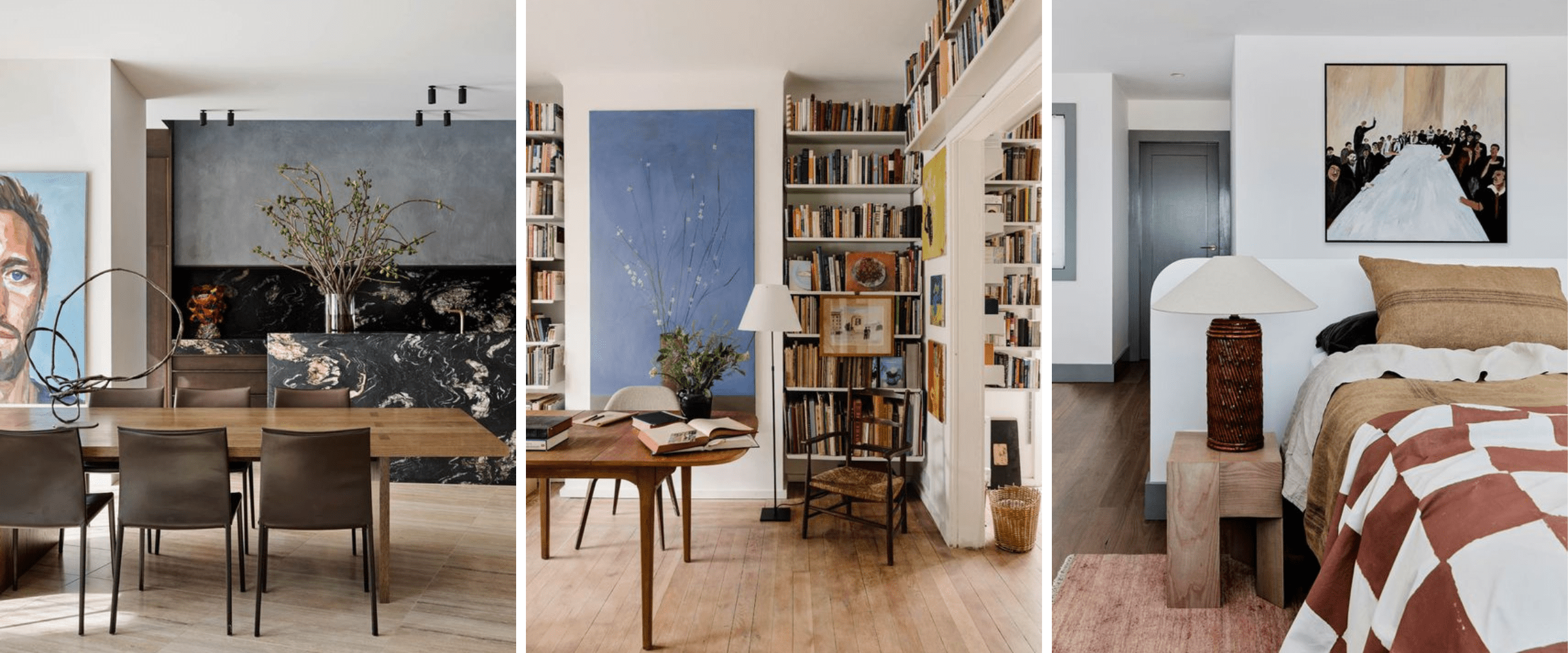
Images via Pinterest.
Accessorizing your home through the art of layering is a creative and fulfilling process that allows you to transform your space into a reflection of your personality, style, and interests. By understanding the principles of layering, you can create a harmonious and visually captivating environment that invites comfort and joy.
The key is to embrace your individuality and create a space that resonates with you. Allow yourself to experiment, try new ideas, and let your creativity flow. Whether you prefer a minimalist approach or a more eclectic style, layering provides endless possibilities for expressing your personal taste and creating a space that feels like home.
Take the time to curate your collection of accessories, selecting pieces that hold sentimental value, evoke positive emotions, and align with your design vision. Consider the balance of elements, the flow of the space, and the importance of negative space. With a thoughtful approach, you can achieve a harmonious composition that feels balanced, inviting, and visually appealing.
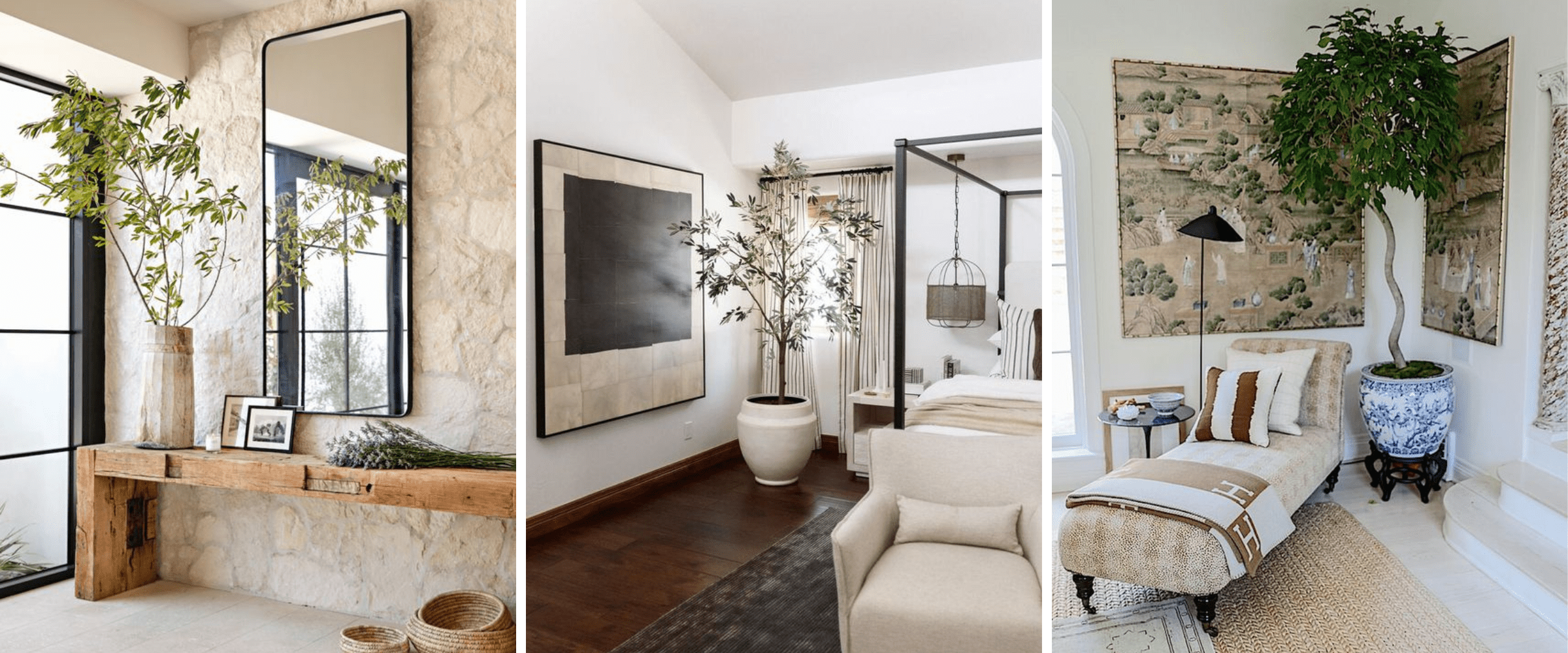
Images via Pinterest.
Remember that layering is not a one-time task but an ongoing process. As you evolve and your tastes change, your home should evolve with you. Take the opportunity to update and refresh your accessories, rotate artwork, and experiment with different arrangements. This allows your space to adapt and grow along with your personal journey.
Ultimately, accessorizing your home through layering is about creating a space that brings you joy, comfort, and a sense of belonging. It’s about surrounding yourself with meaningful objects, cherished memories, and items that inspire you. By carefully curating your layers, you can transform your house into a haven that reflects your unique story and welcomes you with open arms.


